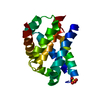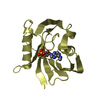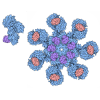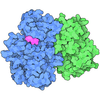[English] 日本語
 Yorodumi
Yorodumi- PDB-6gl8: Crystal structure of Bcl-2 in complex with the novel orally activ... -
+ Open data
Open data
- Basic information
Basic information
| Entry | Database: PDB / ID: 6gl8 | ||||||
|---|---|---|---|---|---|---|---|
| Title | Crystal structure of Bcl-2 in complex with the novel orally active inhibitor S55746 | ||||||
 Components Components | Apoptosis regulator Bcl-2,Apoptosis regulator Bcl-2,Apoptosis regulator Bcl-2,Bcl-2-like protein 1,Apoptosis regulator Bcl-2,Apoptosis regulator Bcl-2,Apoptosis regulator Bcl-2 | ||||||
 Keywords Keywords | APOPTOSIS / APOPTOSIS-INHIBITOR COMPLEX / BCL-2 / BH3-mimetics | ||||||
| Function / homology |  Function and homology information Function and homology informationnegative regulation of cellular pH reduction / negative regulation of retinal cell programmed cell death / pigment granule organization / CD8-positive, alpha-beta T cell lineage commitment / BAD-BCL-2 complex / positive regulation of skeletal muscle fiber development / regulation of glycoprotein biosynthetic process / positive regulation of melanocyte differentiation / channel inhibitor activity / melanin metabolic process ...negative regulation of cellular pH reduction / negative regulation of retinal cell programmed cell death / pigment granule organization / CD8-positive, alpha-beta T cell lineage commitment / BAD-BCL-2 complex / positive regulation of skeletal muscle fiber development / regulation of glycoprotein biosynthetic process / positive regulation of melanocyte differentiation / channel inhibitor activity / melanin metabolic process / positive regulation of neuron maturation / myeloid cell apoptotic process / cochlear nucleus development / osteoblast proliferation / mesenchymal cell development / retinal cell programmed cell death / negative regulation of osteoblast proliferation / stem cell development / gland morphogenesis / renal system process / regulation of cell-matrix adhesion / The NLRP1 inflammasome / dendritic cell apoptotic process / ear development / negative regulation of calcium ion transport into cytosol / lymphoid progenitor cell differentiation / melanocyte differentiation / T cell apoptotic process / negative regulation of myeloid cell apoptotic process / negative regulation of epithelial cell apoptotic process / BH3-only proteins associate with and inactivate anti-apoptotic BCL-2 members / regulation of nitrogen utilization / negative regulation of dendritic cell apoptotic process / glomerulus development / focal adhesion assembly / regulation of transmembrane transporter activity / negative regulation of T cell apoptotic process / oocyte development / B cell apoptotic process / metanephros development / neuron maturation / negative regulation of motor neuron apoptotic process / Regulation of MITF-M-dependent genes involved in apoptosis / positive regulation of multicellular organism growth / regulation of viral genome replication / endoplasmic reticulum calcium ion homeostasis / regulation of mitochondrial membrane permeability / calcium ion transport into cytosol / response to UV-B / negative regulation of ossification / response to iron ion / epithelial cell apoptotic process / negative regulation of mitochondrial depolarization / axon regeneration / motor neuron apoptotic process / positive regulation of smooth muscle cell migration / smooth muscle cell migration / NFE2L2 regulating tumorigenic genes / intrinsic apoptotic signaling pathway in response to oxidative stress / negative regulation of B cell apoptotic process / organ growth / hair follicle morphogenesis / branching involved in ureteric bud morphogenesis / negative regulation of intrinsic apoptotic signaling pathway in response to DNA damage by p53 class mediator / B cell lineage commitment / digestive tract morphogenesis / negative regulation of G1/S transition of mitotic cell cycle / pore complex / negative regulation of intrinsic apoptotic signaling pathway / BH3 domain binding / T cell homeostasis / regulation of calcium ion transport / B cell homeostasis / humoral immune response / B cell proliferation / negative regulation of anoikis / negative regulation of apoptotic signaling pathway / intrinsic apoptotic signaling pathway in response to endoplasmic reticulum stress / extrinsic apoptotic signaling pathway via death domain receptors / Estrogen-dependent nuclear events downstream of ESR-membrane signaling / Activation of BAD and translocation to mitochondria / hematopoietic stem cell differentiation / negative regulation of extrinsic apoptotic signaling pathway in absence of ligand / behavioral fear response / ovarian follicle development / cellular response to glucose starvation / skeletal muscle fiber development / spleen development / positive regulation of B cell proliferation / response to cytokine / extrinsic apoptotic signaling pathway in absence of ligand / homeostasis of number of cells within a tissue / axonogenesis / ossification / reactive oxygen species metabolic process / negative regulation of autophagy / response to glucocorticoid / protein phosphatase 2A binding / negative regulation of cell migration / actin filament organization Similarity search - Function | ||||||
| Biological species |  Homo sapiens (human) Homo sapiens (human) | ||||||
| Method |  X-RAY DIFFRACTION / X-RAY DIFFRACTION /  SYNCHROTRON / SYNCHROTRON /  MOLECULAR REPLACEMENT / Resolution: 1.4 Å MOLECULAR REPLACEMENT / Resolution: 1.4 Å | ||||||
 Authors Authors | Casara, P. / Davidson, J. / Claperon, A. / Le Toumelin-Braizat, G. / Vogler, M. / Bruno, A. / Chanrion, M. / Lysiak-Auvity, G. / Le Diguarher, T. / Starck, J.B. ...Casara, P. / Davidson, J. / Claperon, A. / Le Toumelin-Braizat, G. / Vogler, M. / Bruno, A. / Chanrion, M. / Lysiak-Auvity, G. / Le Diguarher, T. / Starck, J.B. / Chen, I. / Whitehead, N. / Graham, C. / Matassova, N. / Dokurno, P. / Pedder, C. / Wang, Y. / Qiu, S. / Girard, A.M. / Schneider, E. / Grave, F. / Studeny, A. / Guasconi, G. / Rocchetti, F. / Maiga, S. / Henlin, J.M. / Colland, F. / Kraus-Berthier, L. / Le Gouill, S. / Dyer, M.J.S. / Hubbard, R. / Wood, M. / Amiot, M. / Cohen, G.M. / Hickman, J.A. / Morris, E. / Murray, J. / Geneste, O. | ||||||
 Citation Citation |  Journal: Oncotarget / Year: 2018 Journal: Oncotarget / Year: 2018Title: S55746 is a novel orally active BCL-2 selective and potent inhibitor that impairs hematological tumor growth. Authors: Casara, P. / Davidson, J. / Claperon, A. / Le Toumelin-Braizat, G. / Vogler, M. / Bruno, A. / Chanrion, M. / Lysiak-Auvity, G. / Le Diguarher, T. / Starck, J.B. / Chen, I. / Whitehead, N. / ...Authors: Casara, P. / Davidson, J. / Claperon, A. / Le Toumelin-Braizat, G. / Vogler, M. / Bruno, A. / Chanrion, M. / Lysiak-Auvity, G. / Le Diguarher, T. / Starck, J.B. / Chen, I. / Whitehead, N. / Graham, C. / Matassova, N. / Dokurno, P. / Pedder, C. / Wang, Y. / Qiu, S. / Girard, A.M. / Schneider, E. / Grave, F. / Studeny, A. / Guasconi, G. / Rocchetti, F. / Maiga, S. / Henlin, J.M. / Colland, F. / Kraus-Berthier, L. / Le Gouill, S. / Dyer, M.J.S. / Hubbard, R. / Wood, M. / Amiot, M. / Cohen, G.M. / Hickman, J.A. / Morris, E. / Murray, J. / Geneste, O. | ||||||
| History |
|
- Structure visualization
Structure visualization
| Structure viewer | Molecule:  Molmil Molmil Jmol/JSmol Jmol/JSmol |
|---|
- Downloads & links
Downloads & links
- Download
Download
| PDBx/mmCIF format |  6gl8.cif.gz 6gl8.cif.gz | 51.5 KB | Display |  PDBx/mmCIF format PDBx/mmCIF format |
|---|---|---|---|---|
| PDB format |  pdb6gl8.ent.gz pdb6gl8.ent.gz | 34.8 KB | Display |  PDB format PDB format |
| PDBx/mmJSON format |  6gl8.json.gz 6gl8.json.gz | Tree view |  PDBx/mmJSON format PDBx/mmJSON format | |
| Others |  Other downloads Other downloads |
-Validation report
| Summary document |  6gl8_validation.pdf.gz 6gl8_validation.pdf.gz | 872.3 KB | Display |  wwPDB validaton report wwPDB validaton report |
|---|---|---|---|---|
| Full document |  6gl8_full_validation.pdf.gz 6gl8_full_validation.pdf.gz | 875.3 KB | Display | |
| Data in XML |  6gl8_validation.xml.gz 6gl8_validation.xml.gz | 10.2 KB | Display | |
| Data in CIF |  6gl8_validation.cif.gz 6gl8_validation.cif.gz | 14.1 KB | Display | |
| Arichive directory |  https://data.pdbj.org/pub/pdb/validation_reports/gl/6gl8 https://data.pdbj.org/pub/pdb/validation_reports/gl/6gl8 ftp://data.pdbj.org/pub/pdb/validation_reports/gl/6gl8 ftp://data.pdbj.org/pub/pdb/validation_reports/gl/6gl8 | HTTPS FTP |
-Related structure data
| Related structure data |  2w3lS S: Starting model for refinement |
|---|---|
| Similar structure data |
- Links
Links
- Assembly
Assembly
| Deposited unit | 
| ||||||||
|---|---|---|---|---|---|---|---|---|---|
| 1 |
| ||||||||
| Unit cell |
|
- Components
Components
| #1: Protein | Mass: 20236.555 Da / Num. of mol.: 1 Mutation: L95K, Q99E,L95K, Q99E,L95K, Q99E,L95K, Q99E,L95K, Q99E,L95K, Q99E,L95K, Q99E,L95K, Q99E,L95K, Q99E,L95K, Q99E,L95K, Q99E,L95K, Q99E,L95K, Q99E,L95K, Q99E,L95K, Q99E,L95K, Q99E,L95K, ...Mutation: L95K, Q99E,L95K, Q99E,L95K, Q99E,L95K, Q99E,L95K, Q99E,L95K, Q99E,L95K, Q99E,L95K, Q99E,L95K, Q99E,L95K, Q99E,L95K, Q99E,L95K, Q99E,L95K, Q99E,L95K, Q99E,L95K, Q99E,L95K, Q99E,L95K, Q99E,L95K, Q99E,L95K, Q99E,L95K, Q99E,L95K, Q99E,L95K, Q99E,L95K, Q99E,L95K, Q99E,L95K, Q99E,L95K, Q99E,L95K, Q99E,L95K, Q99E,L95K, Q99E,L95K, Q99E,L95K, Q99E,L95K, Q99E,L95K, Q99E,L95K, Q99E,L95K, Q99E,L95K, Q99E,L95K, Q99E,L95K, Q99E,L95K, Q99E,L95K, Q99E,L95K, Q99E,L95K, Q99E,L95K, Q99E,L95K, Q99E,L95K, Q99E,L95K, Q99E,L95K, Q99E,L95K, Q99E,L95K, Q99E,L95K, Q99E,L95K, Q99E,L95K, Q99E,L95K, Q99E,L95K, Q99E,L95K, Q99E,L95K, Q99E,L95K, Q99E,L95K, Q99E,L95K, Q99E,L95K, Q99E,L95K, Q99E,L95K, Q99E,L95K, Q99E,L95K, Q99E,L95K, Q99E,L95K, Q99E,L95K, Q99E,L95K, Q99E,L95K, Q99E,L95K, Q99E,L95K, Q99E,L95K, Q99E,L95K, Q99E,L95K, Q99E,L95K, Q99E,L95K, Q99E,L95K, Q99E,L95K, Q99E,L95K, Q99E,L95K, Q99E,L95K, Q99E,L95K, Q99E,L95K, Q99E,L95K, Q99E,L95K, Q99E,L95K, Q99E,L95K, Q99E,L95K, Q99E,L95K, Q99E,L95K, Q99E,L95K, Q99E,L95K, Q99E,L95K, Q99E,L95K, Q99E,L95K, Q99E,L95K, Q99E,L95K, Q99E,L95K, Q99E,L95K, Q99E,L95K, Q99E,L95K, Q99E,L95K, Q99E,L95K, Q99E,L95K, Q99E,L95K, Q99E,L95K, Q99E,L95K, Q99E,L95K, Q99E,L95K, Q99E,L95K, Q99E,L95K, Q99E,L95K, Q99E,L95K, Q99E,L95K, Q99E,L95K, Q99E,L95K, Q99E,L95K, Q99E,L95K, Q99E,L95K, Q99E,L95K, Q99E,L95K, Q99E,L95K, Q99E,L95K, Q99E,L95K, Q99E,L95K, Q99E,L95K, Q99E,L95K, Q99E,L95K, Q99E,L95K, Q99E,L95K, Q99E,L95K, Q99E,L95K, Q99E,L95K, Q99E,L95K, Q99E,L95K, Q99E,L95K, Q99E,L95K, Q99E,L95K, Q99E,L95K, Q99E,L95K, Q99E,L95K, Q99E,L95K, Q99E,L95K, Q99E,L95K, Q99E,L95K, Q99E,L95K, Q99E,L95K, Q99E,L95K, Q99E,L95K, Q99E,L95K, Q99E,L95K, Q99E,L95K, Q99E,L95K, Q99E,L95K, Q99E,L95K, Q99E,L95K, Q99E,L95K, Q99E,L95K, Q99E,L95K, Q99E,L95K, Q99E,L95K, Q99E,L95K, Q99E,L95K, Q99E,L95K, Q99E,L95K, Q99E,L95K, Q99E,L95K, Q99E,L95K, Q99E,L95K, Q99E,L95K, Q99E,L95K, Q99E,L95K, Q99E,L95K, Q99E,L95K, Q99E,L95K, Q99E,L95K, Q99E,L95K, Q99E,L95K, Q99E,L95K, Q99E,L95K, Q99E,L95K, Q99E,L95K, Q99E,L95K, Q99E,L95K, Q99E,L95K, Q99E,L95K, Q99E,L95K, Q99E,L95K, Q99E,L95K, Q99E,L95K, Q99E,L95K, Q99E,L95K, Q99E,L95K, Q99E,L95K, Q99E,L95K, Q99E,L95K, Q99E,L95K, Q99E,L95K, Q99E,L95K, Q99E,L95K, Q99E,L95K, Q99E,L95K, Q99E,L95K, Q99E,L95K, Q99E,L95K, Q99E,L95K, Q99E,L95K, Q99E,L95K, Q99E,L95K, Q99E,L95K, Q99E,L95K, Q99E,L95K, Q99E,L95K, Q99E,L95K, Q99E,L95K, Q99E,L95K, Q99E Source method: isolated from a genetically manipulated source Source: (gene. exp.)  Homo sapiens (human) / Gene: BCL2, BCL2L1, BCL2L, BCLX / Production host: Homo sapiens (human) / Gene: BCL2, BCL2L1, BCL2L, BCLX / Production host:  |
|---|---|
| #2: Chemical | ChemComp-F3Q / ~{ |
| #3: Water | ChemComp-HOH / |
-Experimental details
-Experiment
| Experiment | Method:  X-RAY DIFFRACTION / Number of used crystals: 1 X-RAY DIFFRACTION / Number of used crystals: 1 |
|---|
- Sample preparation
Sample preparation
| Crystal | Density Matthews: 1.76 Å3/Da / Density % sol: 29.7 % |
|---|---|
| Crystal grow | Temperature: 284 K / Method: vapor diffusion, hanging drop / pH: 5.25 Details: 0.1 M sodium acetate buffer pH 5.25, 20% Jeffamine600, 10% PEG3350 |
-Data collection
| Diffraction | Mean temperature: 100 K |
|---|---|
| Diffraction source | Source:  SYNCHROTRON / Site: SYNCHROTRON / Site:  SOLEIL SOLEIL  / Beamline: PROXIMA 1 / Wavelength: 0.97857 Å / Beamline: PROXIMA 1 / Wavelength: 0.97857 Å |
| Detector | Type: DECTRIS PILATUS3 S 6M / Detector: PIXEL / Date: Nov 23, 2016 |
| Radiation | Protocol: SINGLE WAVELENGTH / Monochromatic (M) / Laue (L): M / Scattering type: x-ray |
| Radiation wavelength | Wavelength: 0.97857 Å / Relative weight: 1 |
| Reflection | Resolution: 1.39→42.5 Å / Num. obs: 28969 / % possible obs: 98.9 % / Redundancy: 4.2 % / CC1/2: 0.999 / Rmerge(I) obs: 0.034 / Rpim(I) all: 0.019 / Rrim(I) all: 0.039 / Net I/σ(I): 19.5 |
| Reflection shell | Resolution: 1.39→1.42 Å / Redundancy: 3.7 % / Rmerge(I) obs: 0.54 / Mean I/σ(I) obs: 2.2 / Num. unique obs: 1967 / CC1/2: 0.877 / Rpim(I) all: 0.31 / Rrim(I) all: 0.63 / % possible all: 91.7 |
- Processing
Processing
| Software |
| ||||||||||||||||||||||||||||||||||||||||||||||||||||||||||||||||||||||||||||||||||||||||||||||||||||||||||||||||||||||||||||||||||||||||||||||||||||||||||||||||||||||||||||||||||||||
|---|---|---|---|---|---|---|---|---|---|---|---|---|---|---|---|---|---|---|---|---|---|---|---|---|---|---|---|---|---|---|---|---|---|---|---|---|---|---|---|---|---|---|---|---|---|---|---|---|---|---|---|---|---|---|---|---|---|---|---|---|---|---|---|---|---|---|---|---|---|---|---|---|---|---|---|---|---|---|---|---|---|---|---|---|---|---|---|---|---|---|---|---|---|---|---|---|---|---|---|---|---|---|---|---|---|---|---|---|---|---|---|---|---|---|---|---|---|---|---|---|---|---|---|---|---|---|---|---|---|---|---|---|---|---|---|---|---|---|---|---|---|---|---|---|---|---|---|---|---|---|---|---|---|---|---|---|---|---|---|---|---|---|---|---|---|---|---|---|---|---|---|---|---|---|---|---|---|---|---|---|---|---|---|
| Refinement | Method to determine structure:  MOLECULAR REPLACEMENT MOLECULAR REPLACEMENTStarting model: 2W3L Resolution: 1.4→20 Å / Cor.coef. Fo:Fc: 0.97 / Cor.coef. Fo:Fc free: 0.966 / SU B: 1.12 / SU ML: 0.044 / Cross valid method: THROUGHOUT / ESU R: 0.066 / ESU R Free: 0.064 / Details: HYDROGENS HAVE BEEN ADDED IN THE RIDING POSITIONS
| ||||||||||||||||||||||||||||||||||||||||||||||||||||||||||||||||||||||||||||||||||||||||||||||||||||||||||||||||||||||||||||||||||||||||||||||||||||||||||||||||||||||||||||||||||||||
| Solvent computation | Ion probe radii: 0.8 Å / Shrinkage radii: 0.8 Å / VDW probe radii: 1.2 Å | ||||||||||||||||||||||||||||||||||||||||||||||||||||||||||||||||||||||||||||||||||||||||||||||||||||||||||||||||||||||||||||||||||||||||||||||||||||||||||||||||||||||||||||||||||||||
| Displacement parameters | Biso mean: 23.1 Å2
| ||||||||||||||||||||||||||||||||||||||||||||||||||||||||||||||||||||||||||||||||||||||||||||||||||||||||||||||||||||||||||||||||||||||||||||||||||||||||||||||||||||||||||||||||||||||
| Refinement step | Cycle: 1 / Resolution: 1.4→20 Å
| ||||||||||||||||||||||||||||||||||||||||||||||||||||||||||||||||||||||||||||||||||||||||||||||||||||||||||||||||||||||||||||||||||||||||||||||||||||||||||||||||||||||||||||||||||||||
| Refine LS restraints |
|
 Movie
Movie Controller
Controller












 PDBj
PDBj






